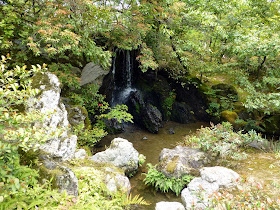When sightseeing in specific countries or cities, there are places you just have to go. In London, you see Big Ben and Buckingham Palace. Paris has the Eiffel Tower. New York has the Statue of Liberty. And Kyoto has Kinkakuji.
Kyoto is certainly well-known for its cultural and religious sightseeing landmarks, but there are a few places every Japanese traveler has been to if they've gone to Kyoto on vacation. One of those is Kinkakuji. The name sounds wonderful: it translates as Golden Pavilion. And it lives up to its name: it is a pavilion of gold. But how great is this old, historic, valuable building?After paying your money and entering the gates, you begin the approach. The temple is set a little ways back from the gates, on the opposite side of a lake.
And that's where you first see it. Kinkakuji really is a pavilion covered from top to bottom in gold.
Well, almost bottom. The first floor is just wood. Each floor has a different architectural style: the first is Shinden style, used for palaces in the Heian Period. The second floor is Bukke style used in samurai residences, covered in gold on the outside, and houses statues that are never shown to the public. The third floor is a traditional Chinese Zen hall, and is gold both inside and out.
The building has burned down several times, most recently in 1950 due to a fanatic monk. The current building was finished in 1955.
It is quite difficult to see, especially because my photos are a bit hazy, but the windows on the first floor are open, and you can see the statues inside. This is usually the case.
The pavilion is certainly well-placed with several beautiful angles to take pictures over the lake. Would you like a pine tree obscuring part of the building or not? Perhaps a small bit of an island in front of it to add some depth?The path continues and you end up on the back side of the pavilion, permitting you a closer look at the structure.
All that gold is beautifully shiny, but there isn't any contrast which sadly means it also looks somewhat like a cheap toy. You know, one of those toys you got painted in gold paint? Or perhaps an inexpensive souvenir you bought by the side of the road?
From the back, you can see the roof's topping: a golden phoenix. Too bad this view is from the back too. But if you ever wanted to see what a golden phoenix looked like in an up-skirt shot, well, there you go.
Kinkakuji's grounds are nowhere near as impressive as Ginkakuji's, though there is a small cave.
Heading along the trail you'll come to a small waterfall.
Some rock carvings with lots of offerings. I believe if you toss a coin into the bowl and it stays inside, your wish comes true.
A light forest with a stone pagoda next to another pond. I think there are some off-limits sacred grounds attached to Kinkakuji.
Kinkakuji from a different angle, poking its best assets over the trees.
Here's the phoenix from a slightly sideways angle. I guess a phoenix is a good choice for a building that has burned to the ground several times only to rise again.
Another view of the stone pagoda.
If you come on a busy day, like I did during Golden Week, you can expect the crowds to be quite heavy. The best viewing points of the golden pavilion will be swarming with tourists carrying very expensive cameras to take their awesome photos and cellphones to take their selfies.
There are some small shrines at which to pray near the end of the one-way path before you exit toward the gift shop. There is a tea house just before exiting, but you can enjoy matcha (green tea) and sweets at the tea garden just outside the gates. Fudo Hall, seen above, is nearby and houses a statue said to be carved by Kobo Daishi, one of the most important historical Japanese religious figures.
While the pavilion is amazing to see - an entire building covered in gold! - the one-trick-pony aspect of this site meant that I was really only paying to see a building. And I've done that before, but usually it includes a tour inside or some auxiliary sites; Ginkakuji had the beautiful gardens, observation towers have observation decks, and Abashiri Prison and other architectural museums tell interesting stories about the building and its use through exhibits and experiences.
That isn't to say Kinkakuji isn't worth visiting - it is. Just know what you're getting to see!
Bus numbers 101 and 205 go from Kyoto Station to Kinkakuji, the cheapest and easiest way to get there. However, Kyoto can have heavy traffic, so you can take the Karasuma subway line to Kitaoji Station and catch the 101, 102, 204, or 205 bus to the temple. The subway-bus route is more than double the price, though it is a bit faster and much more reliable on time.
Admission is 400 yen, and the grounds are open 9:00-17:00. While there are plenty of things to see and do in northern Kyoto, there really aren't any other tourist stops near Kinkakuji, so plan your onward destination before leaving Kyoto Station.
























No comments:
Post a Comment